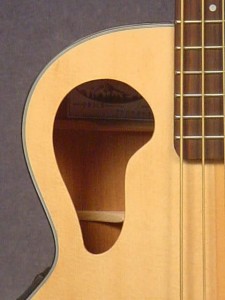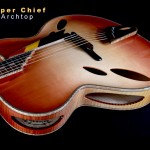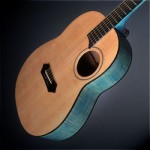Offset Soundhole Guitars: It’s a Love/Hate Thing
 I’ve always been intrigued by the whole concept of offset soundhole guitars – why is the soundhole normally dead centre? Is there a sonic reason or just a tradition that’s never been updated? Technical questions aside, there’s also the whole visual thing. Some people hate ‘em, but some find them strangely attractive – and that’s me. Read on to see a few cool examples and get a bit of background…
I’ve always been intrigued by the whole concept of offset soundhole guitars – why is the soundhole normally dead centre? Is there a sonic reason or just a tradition that’s never been updated? Technical questions aside, there’s also the whole visual thing. Some people hate ‘em, but some find them strangely attractive – and that’s me. Read on to see a few cool examples and get a bit of background…
First port of call on my journey of discovering a bit more, was finding an excellent article entitled “The Holey Grail – Why leading guitar makers are rethinking traditional soundhole designs” by Teja Gerken that originally ran in Acoustic Guitar magazine. It’s a good read if you are interested, but the basic takeout is that for a long while there wasn’t much science to the location of the soundhole – it was more about a convenient spot to put it! It was only when some luthiers started thinking about changing the shape of the soundhole that they realized that some variations simply wouldn’t work as they would end up being in a structurally sensitive location. The result was the move to an upper bout location (on the bass side) which is probably the most common alternative location.
Another consideration is that anyone who has ever covered the hole of a guitar with a feedback buster, knows that most of the sound comes through the top, not the soundhole. Put a soundhole in the middle and you need reasonably solid bracing for the top. Offset the soundhole to a “corner” and the top can use lighter braces and therefore vibrate more. Seems to make sense.
The extension of this is to move the soundhole off the top of the guitar and onto the side. Long Island archtop guitar builder John Monteleone figured the side hole would enable the player to hear the sound they were making better so he built one. As he says in the Gerken article: “It did its job of projecting the sound to the player admirably. It’s like sticking your head in the guitar. There is a very direct focusing of sound to the player. I thought it would sacrifice forward projection to the audience, but the real surprise was that there was almost no change at all. It was working both ways.”
So while most manufacturers haven’t jumped on board, there remains a crew of custom builders who are committed to the cause, and are making some really fascinating instruments. Below is a gallery of a few images I’ve found online. If you like the look do a search around the builders name – most of them have excellent websites where there’s a bunch more information.
The point of this piece is as a reminder that the traditional approach isn’t the only approach – and that trying different things, whether it’s building a guitar or writing a song, is always a good thing! I’d love an offset soundhole guitar – I just need to find one!
- Chuck Morrison Guitars
- Martin Keith Auriole
- Monteleone Super Chief
- Kohei Fujii Guitars
- Randy Reynolds Quattro
- Backbird Guitars Super OM
- Schwartz Oracle offset
- S.B. McDonald Custom Built
- McPherson Offset











Pingback: Works Cited – Jonathan Hanson
Heard about this. Been playing for awhile and I am hearing impaired. Self taught and playing 2 1/2 years (I am 68). Never been happier than when playing. Pretty much went to electric because I could not hear my acoustic without a pickup. I noticed that when I stood in front of a player I could hear significantly better.Then I heard about these! Is the cost prohibitive? Would like some details because my acoustic has been in the case for two years and I’d really love to hear it’s sound the way I can when someone else is playing.
This would solve a lot of issues for me. I am hearing impaired with 35% to 45% loss. Since I can hear my acoustic up close and facing another party playing it, it should certainly follow that I will be able to hear even better when I am playing a side hole offset myself. Would like to hear natural sound and move away from from pickup/amp setup I have now. Can someone please tell me how to get one? Thank you.
Michael Kelly have severely in expensive models.
Just want to mention, that it’s a looong time the guitars respectively somewhat similar string instruments (lutes, ouds etc) have been built with all kinds of hole (or not hole) placements and sizes. Seriously nothing new here 😉
I have a Mansfield acoustic purchased new about 1994. No other identifying marks or serial number.
Offset sound holes. M is fancier than the Mansfields that came out of Montreal. Probably from China. Very attractive design. Anyone familiar with such an item?
Thanks for any help.